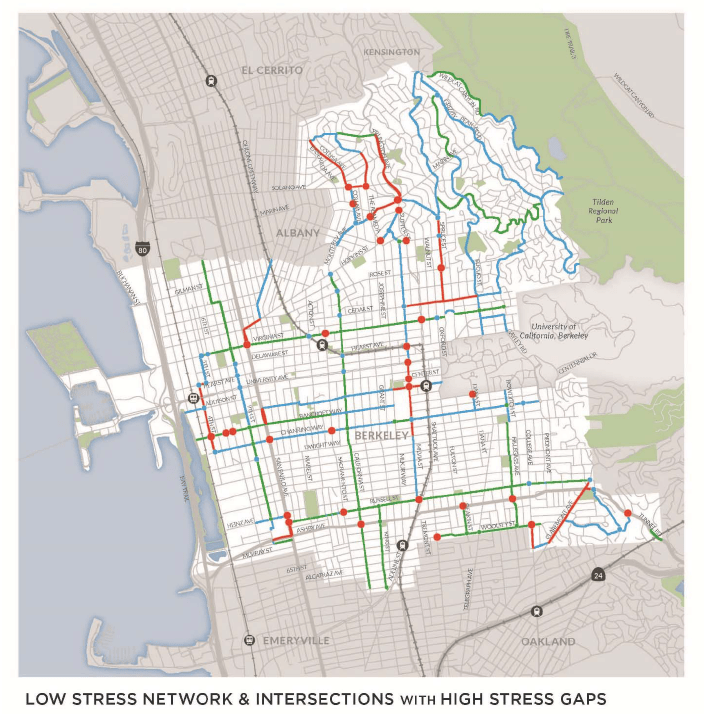
The most recent cap-and-trade allocation bill, A.B. 1613, allots $10 million to the Active Transportation Program. The money comes with a few strings attached. Any projects funded by cap-and-trade have to show that they reduce greenhouse gas emissions. Also, the money must be allocated by 2018 and spent by 2020.
This is not likely to present huge problems, but California Transportation Commission staff held a meeting Thursday to discuss their proposed guidelines for these funds with stakeholders, and they are accepting public comments on them through Friday (submit comments to mitchell.weiss [at] dot.ca.gov).
Since the Active Transportation Program already incorporates goals to encourage people to walk and bike rather than drive, the question of whether ATP projects reduce greenhouse gas emissions could be met with a collective “DUH!” to quote our former governor Arnold Schwarzenegger.
But it is a hoop to jump through. The Air Resources Board has a tool for estimating greenhouse gas emissions reductions, and interested applicants will need to add it to their already complex applications. The tool is undergoing an update, but for the moment it incorporates data such as an estimate of annual average daily traffic on parallel roadways, the length of a project, and the number of activity centers like hospitals and transit stations near the project.
Applicants will also need to estimate the total cost per ton of greenhouse gas emission reduction, which reflects a move towards quantifying the cost of reductions across all cap-and-trade investments. The focus on cost could be misleading, however, since there are so many other benefits that come from people bicycling and walking that don't get quantified in a simple cost ratio. Nevertheless, ATP projects in general are likely to do well on this score, if prepared accurately. Bike lanes are a lot less expensive than most infrastructure projects, for example.
Having to use the money quickly is also not likely to be a big issue. The current round of funding won't be allocated until 2019 at the earliest—staff recommendations for those projects will be released later this month. Many of them will be on their second, third, or fourth application. For the most part they weren't rejected because they didn't meet program goals, but because the ATP is oversubscribed and underfunded.
The city of Berkeley, to pick one example, has identified millions of dollars worth of projects that could qualify for ATP funding, and has submitted some projects for consideration as many as five times. From Berkeley's perspective, the problem is not whether they can qualify nor whether they can produce a project quickly, but whether there is enough funding.
CTC plans to award the additional $10 million from cap-and-trade to projects that can be completed by the 2020 deadline, thus leaving a little more money in the $250 million pot available for the rest of the program. For the right projects, the accelerated schedule is likely to be a good thing.
Another requirement for cap-and-trade investments is for a portion of projects to show a benefit to disadvantaged communities. The ATP has its own goals regarding investing in communities that need it most, with a slightly different way of measuring what makes a community disadvantaged. So far the program has more than met its own goals. To comply with the separate cap-and-trade rules, staff plan to ensure that at least half of the $10M meets the requirements of A.B. 1550, which calls for minimum percentages to benefit low-income communities and areas identified by CalEnviroScreen scores as disadvantaged.
There are some concerns about what types of projects would qualify for the cap-and-trade money. CTC staff made it clear that commissioners prefer infrastructure projects and would rather not fund planning or programming, like events or education. There was a lot of pushback at the meeting on this, however, and staff said they would consider reconsidering the issue.
However, even if this $10 million goes only for construction projects, there would still be funding available for noninfrastructure projects in the remaining $250 million.
The $10 million is a one-time allocation, unlike some of the other cap-and-trade investments that count on a certain percentage of the Greenhouse Gas Reduction Fund every year. It's also not a lot of money, especially given the strong demonstrated need and the number of qualified projects that haven't received funding in past rounds. But it's another little step in the right direction.





